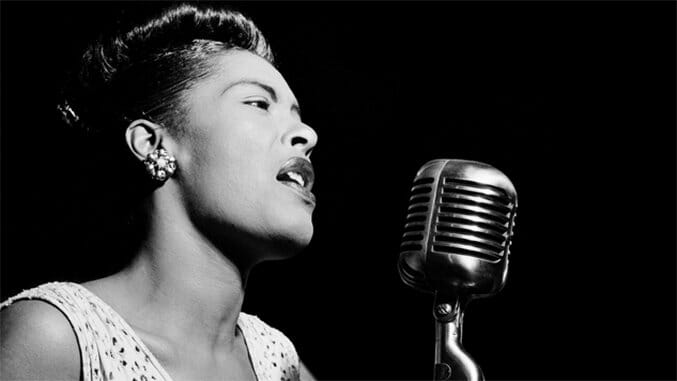The 10 Best Billie Holiday Songs

Arguably the most recognizable voice in vocal jazz history, Billie Holiday is the epitome of style. Born in the poor part of Baltimore to two teenage parents, Billie turned to music as a way to support herself. At 15 years old, after moving to New York City with her mother, she started singing in Harlem nightclubs for tips. At 18 years old, record producer John Hammond discovered her at a club and took her under his wing. She quickly became of the most coveted singers around, performing with the Duke Ellington orchestra and then eventually Count Basie and Artie Shaw. Frequent musical collaborator and dear friend, tenor saxophonist Lester Young, gave her the nickname “Lady Day.”
Though her musical career seems a success story, Holiday’s personal life was tumultuous. She was heavy into alcohol and heroin, which, along with her tempestuous love life, often got in the way of her career. She died in 1959 at the young age of 44, but her interpretations of blues and jazz standards are the quintessential versions to this day, and her unique voice has inspired countless singers from Ray Charles to Amy Winehouse. Here are the 10 best songs by Billie Holiday.
10. “I’ll Be Seeing You”
Though Holiday recorded many versions of this classic song over her careers, perhaps her most heartfelt recording of it is the one she did live at Carnegie Hall in 1956. Just three years before she died, her voice is audibly weaker and rougher than previous recordings she’d done of the song in the late-1940s. Though the song bore special cultural significance for soldiers going off to World War II, this late version comes off much more personal to Holiday, as if she knew her health were rapidly deteriorating. As she sings “I’ll be seeing you / In all the familiar places,” it’s almost as if she knew she was going to have an indelible impact, and that her contributions would be revisited again and again after her death.
9. “Billie’s Blues (I Love My Man)”
Written by Holiday herself, “Billie’s Blues” (also just known as “I Love My Man”) had to make this list. With lyrics like, “I’ve been your slave / ever since I’ve been your babe / but before I’ll be your dog / I’ll see you in your grave,” listeners finally get to hear a little of what’s on Lady Day’s mind. She’s no longer the star-struck lover or the lonely girl, but finally, the strong, defiant woman who’s done putting up with the men who’ve done her wrong. “Billie’s Blues” highlights Holiday’s spunk, making it such a memorable listen. The best recording of it is the slower, more sorrowful version she did with Eddie Heywood & His Orchestra in 1944.
8. “The Very Thought of You”
Billie Holiday released her version this popular Ray Noble song in 1938. Even early in her career, Holiday’s youthful voice shows range and flexibility on this track. Her delivery of the naively romantic lyrics feels especially authentic and you can tell she believes the lyrics she’s singing because the song doesn’t quite have the tinge of sadness of the love songs of her later years.
7. “Them There Eyes”
In contrast to all of her slow, lonely ballads—which she’s undoubtedly the master of—Holiday’s version of “Them There Eyes” is cheery and flirtatious. Her playful delivery of, “I’m fallin’ / No stallin’ / In a great big way for you,” surely left plenty of gentlemen in the audience weak in the knees. The 1949 recording of the song with Sy Oliver & His Orchestra is the notable version: her voice weaves in and out of surprising, punctuated trumpets, eventually building to an all-out call and response between her and the band. Also, this is perhaps Billie’s most danceable recording, so get your swing dancing shoes and pop this one on the record player.
6. “You’re My Thrill”
There’s something magical about Holiday’s voice in conjunction with the orchestra on this track. Conducted by Gordon Jenkins, the orchestra balances out her subtle singing with dramatic string crescendos and woodwind lines. This 1946 version of “You’re My Thrill” sticks out as one of the most unique recordings that the singer ever did—a definite diversion from fronting jazz bands of the day, or crooning in intimate quartets. The slight change of sound (some have called it more “commercial”) can be attributed to her recording on Decca Records from 1944 to 1950, and their desire to market Holiday beyond jazz.
-

-

-

-

-

-

-

-

-

-

-

-

-

-

-

-

-

-

-

-

-

-

-

-

-

-

-

-

-

-

-

-

-

-

-

-

-

-

-

-








































